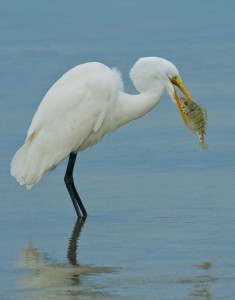We have much more to do and your continued support is needed now more than ever.
8 Wild Creatures That Use Tools in Extraordinary Ways

But, such “in the moment” uses of tools do not really capture the extraordinary and often surprising abilities of some animals to think ahead and use tools in innovative ways.
Nutcrackers, Alarms, Depth Testers, Floss, Nose Guards and More
Crows offer one such example. They have made a clever adaptation to modern society through the use of automobiles. While they surely don’t drive, they have figured out that the crushing weight of a car or truck can crack walnuts and other delicacies. Crows will place their prospective treats on the road and wait for a passing vehicle. They know exactly where the wheels are most likely to fall on the roadway!
Crows, considered by many to be among the brightest of creatures, have also been seen dropping stones into a water pitcher with a narrow neck in order to raise the water level sufficiently to take a drink.
Orangutans have made an adaptation that uses leaves to ward off predators. They don’t shake the leaves at the menace but, instead, make “whistles” from the leaves that make a shrill sound in an effort to scare the threat away.
As a safety measure, gorillas and other apes will approach a body of water with a stick specifically selected to test the depth of the water they would like to cross. They don’t swim so the stick becomes an important survival tool.
In Thailand, macaques (small apes) will use their stealth to pluck hair from the heads of tourists and others and use it to floss their teeth. Adult macaques have been seen applying this tooth cleaning method in elaborate slow motion as a way to teach this dental care to juveniles.

Dolphins, often considered to be one of the most intelligent of all mammals have been seen pulling off pieces of sponge, wrapping it around their beaks and then using to forage along a sandy sea bottom for food. The sponge protects their beaks from irritations and abrasions.
Perhaps the most elaborate “tool” user is the bowerbird of Australia. It collects shiny objects such as bottle caps and pieces of glass to make an elaborate (and wholly attractive) nest that will lure a mate. Many days will go into the preparation of the nest and only the finest shiny items will be selected.
These insights into how wild creatures innovate and think ahead can help us all to appreciate their extraordinary lives and abilities.
For more EXTRA-ordinary wildlife facts, check out the National Wildlife Week website >>





















